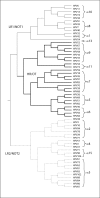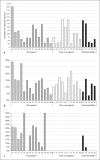Human papillomaviruses: genetic basis of carcinogenicity
- PMID: 19684441
- PMCID: PMC2835381
- DOI: 10.1159/000214919
Human papillomaviruses: genetic basis of carcinogenicity
Abstract
Persistent infection by specific oncogenic human papillomaviruses (HPVs) is established as the necessary cause of cervix cancer. DNA sequence differences between HPV genomes determine whether an HPV has the potential to cause cancer. Of the more than 100 HPV genotypes characterized at the genetic level, at least 15 are associated, to varying degrees, with cervical cancer. Classification based on nucleotide similarity places nearly all HPVs that infect the cervicovaginal area within the alpha-PV genus. Within this genus, phylogenetic trees inferred from the entire viral genome cluster all cancer-causing types together, suggesting the existence of a common ancestor for the oncogenic HPVs. However, in separate trees built from the early open reading frames (ORFs; i.e. E1, E2, E6, E7) or the late ORFs (i.e. L1, L2), the carcinogenic potential sorts with the early region of the genome, but not the late region. Thus, genetic differences within the early region specify the pathogenic potential of alpha-HPV infections. Since the HPV genomes are monophyletic and sites are highly correlated across the genome, diagnosis of oncogenic types and non-oncogenic types can be accomplished using any region across the genome. Here we review our current understanding of the evolutionary history of the oncogenic HPVs, in particular, we focus on the importance of viral genome heterogeneity and discuss the genetic basis for the oncogenic phenotype in some but not all alpha-PVs.
Copyright 2009 S. Karger AG, Basel.
Figures





Similar articles
-
Phylogenetic incongruence among oncogenic genital alpha human papillomaviruses.J Virol. 2005 Dec;79(24):15503-10. doi: 10.1128/JVI.79.24.15503-15510.2005. J Virol. 2005. PMID: 16306621 Free PMC article.
-
K-Mer Analyses Reveal Different Evolutionary Histories of Alpha, Beta, and Gamma Papillomaviruses.Int J Mol Sci. 2021 Sep 6;22(17):9657. doi: 10.3390/ijms22179657. Int J Mol Sci. 2021. PMID: 34502564 Free PMC article.
-
Human papillomavirus (HPV) types 101 and 103 isolated from cervicovaginal cells lack an E6 open reading frame (ORF) and are related to gamma-papillomaviruses.Virology. 2007 Apr 10;360(2):447-53. doi: 10.1016/j.virol.2006.10.022. Epub 2006 Nov 22. Virology. 2007. PMID: 17125811 Free PMC article.
-
Biology and pathological associations of the human papillomaviruses: a review.Malays J Pathol. 1998 Jun;20(1):1-10. Malays J Pathol. 1998. PMID: 10879257 Review.
-
[Molecular basis of cervical carcinogenesis by high-risk human papillomaviruses].Uirusu. 2008 Dec;58(2):141-54. doi: 10.2222/jsv.58.141. Uirusu. 2008. PMID: 19374192 Review. Japanese.
Cited by
-
Cervical Dysplasia, Infection, and Phylogeny of Human Papillomavirus in HIV-Infected and HIV-Uninfected Women at a Reproductive Health Clinic in Nairobi, Kenya.Biomed Res Int. 2020 Jun 16;2020:4945608. doi: 10.1155/2020/4945608. eCollection 2020. Biomed Res Int. 2020. PMID: 32685493 Free PMC article.
-
Structural comparison of four different antibodies interacting with human papillomavirus 16 and mechanisms of neutralization.Virology. 2015 Sep;483:253-63. doi: 10.1016/j.virol.2015.04.016. Epub 2015 May 19. Virology. 2015. PMID: 25996608 Free PMC article.
-
Molecular biology of gynecological cancer.Oncol Lett. 2016 Jan;11(1):16-22. doi: 10.3892/ol.2015.3862. Epub 2015 Nov 5. Oncol Lett. 2016. PMID: 26834851 Free PMC article.
-
The genetic variability, phylogeny and functional significance of E6, E7 and LCR in human papillomavirus type 52 isolates in Sichuan, China.Virol J. 2021 May 3;18(1):94. doi: 10.1186/s12985-021-01565-5. Virol J. 2021. PMID: 33941222 Free PMC article.
-
Public Health Genomics: Time to Sharpen the Focus.Public Health Genomics. 2023;26(1):171-176. doi: 10.1159/000533985. Epub 2023 Sep 20. Public Health Genomics. 2023. PMID: 37729876 Free PMC article. No abstract available.
References
Publication types
MeSH terms
Grants and funding
LinkOut - more resources
Full Text Sources
Other Literature Sources
Medical
Research Materials

